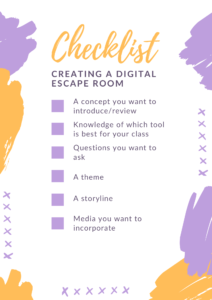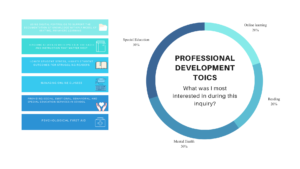
Introduction
Escape rooms provide fun and engaging opportunities for people to exercise their problem solving skills while working together with other people. Based on their recreational popularity, escape rooms seem to be intrinsically motivating, at least for some people. When engagement intersects with intellectual challenge, as seems to be the case with escape rooms, those of us with an interest in education are likely to wonder whether the activity can be brought into the classroom in one way or another. Well, there’s no need to wonder about it any longer- teachers have been using escape rooms in the classroom. Escape rooms are well-suited to classroom use because they promote collaboration and engagement (Nicholson, 2018). Specifically, the time-limit, challenging puzzles, and participatory narrative can all encourage engaged learning (Nicholson, 2018). A google search for “Escape Room Classroom” or a related term will reveal numerous teacher blogs providing step-by-step instructions for creating educational escape rooms. For example, this one or this one, which both outline the process of creating an escape room for a high school English Language Arts (ELA) class. However, if you are looking to create an escape room experience that doesn’t require in-person interaction (of major concern during the current covid-19 pandemic) or purchasing a large amount of locks (not always in the budget), look no further than the digital escape room!
The digital games can have the same essential features as the in-person iterations: a time-limit, clues to find, puzzles to be solved, and an underlying narrative. Accordingly, the digital escape room, like the non-digital version, has been successfully adapted by teachers for use in the classroom. For our project, we wanted to explore how escape rooms can be used to promote learning specifically in highschool ELA classrooms. Some key questions, around which we’ve organized our inquiry, are as follows:
- What ELA content is best suited for use in a digital escape room?
- How can teachers create digital escape rooms? (programs, methods, etc.)
- What should teachers keep in mind when they’re creating or using a digital escape room in the classroom?
- How can digital escape rooms be best incorporated into a lesson sequence or unit?
As described in this blog post, there are two main methods used to create digital escape rooms for the classroom. Google Forms is often used for creating escape rooms- students effectively have to progress through the questions that relate to specific story or challenge. Another way of creating a digital escape room is by using both Google Forms as well as other google applications, namely Google Slides. As described in this video tutorial, teachers can create a digital classroom using google slides that has elements which can be clicked on and redirect students to other content such as a form or document. These clickable elements essentially serve as the clues for the puzzle; students are challenged to finding all the clues and figure out how to “escape” the digital room, often involving a code or password that needs to be entered into a Google Forms. We were also interested in the possibility of using Twine, an online tool used to make interactive stories, to create escape rooms. We decided to create two digital escape rooms for this project; one using Google Forms as a way to review Shakespeare’s Macbeth, and the other using Twine to introduce poetry. Using two different platforms also allowed us to explore the benefits and disadvantages of each platform.
The Process of Creating an Escape Room
Interested in checking out the escape rooms we made? Want to test your knowledge of ELA concepts? Click on the links below to access our digital escape rooms:
Using Twine (Karlie)
In regards to creating digital escape rooms, Twine is a good program for those who are relatively tech-savvy and who want some added flexibility in the way they format the experience. The appearance of the Twine interface is completely customizable, unlike Google Forms. Furthermore, it allows for the integration of other media including images, videos, and audio files. Therefore, escape rooms created with Twine can be more complex and immersive than those on Google Forms, allowing for greater interaction between the game and the player. However, being able to manipulate these features can require a lot of time and effort spent learning how to use Twine. The poetry escape room created for this assignment required hours of research into Twine programming and html editing. This is mostly because I tried to explore different ways of incorporating questions that did not only involve multiple choice or true and false answers, which is very difficult to do without an extensive knowledge of Twine.
If you are looking for a very quick and simple option, and you have not used Twine before, Google Forms might be your best bet. That being said, there is a lot of flexibility in terms of how complex you decide to go with the escape room. The poetry escape room involved finding multiple keys, using random objects to complete tasks, and searching multiple areas of a room. If you want to make a more simple interactive-story style escape room, where players answer questions and move from step-to-step in a linear fashion, then a basic knowledge of Twine will be sufficient. Lastly, in comparison to Google Forms, Twine offers no opportunity for formal assessment beyond monitoring your student’s progress as they work through the escape room.
Benefits of using Twine:
- Offers more customization and complexity
- Have more control over escape room design
- Allows integration of media
Disadvantages of using Twine:
- Can be hard to use/learn
- Can take a long time to create an escape room
- Works best for multiple choice or true/false answers
- No formative assessment
Using Google Forms (Amber)
Google Forms is a simple, straightforward tool you can use when creating your digital escape room. While it does not have the customization options that Twine does, it shines in helping assess your students’ responses. As the form creator, you can see the responses of your students! While you can set a question so that the student must input a set answer to move on, one benefit of Google Forms is that you don’t need to do this. While creating my digital escape room, I wanted to allow students’ to have more open responses. No matter what they input, my escape room on Google Forms pushes them to the next question. I think using this approach would be especially helpful for literary analysis questions, but mixing in a few questions on key facts can be useful, too.
Digital escape rooms on Google Forms do not have to be as linear as the one I created, though. One option you might find useful is the feature to move students to a different section depending on their answer for a multiple choice question. This could help make your escape room more interactive and complex, although this only applies to multiple choice answers. Using this option could also be used to ask students how confident they feel with the material! Clicking that they want to review a little more first could bring them to a page that contains digital copies of the handouts you’ve used in class.
Benefits of Google Forms:
- User-friendly
- Student responses are viewable to the form creator, making it useful as a formative assessment
- Can be used with smartphones, tablets, laptops, and computers
- Less media can make it less overwhelming or distracting for students, especially those disabilities such as ADHD and autism
- Allows open responses
Disadvantages:
- Its simplicity can be less engaging for students
- Using an open response field does not allow students to immediately check their understanding
Conclusions
Through the process of researching and building our own escape rooms, we came to the conclusion that digital escape rooms can undoubtedly be used in the ELA classroom to provide a fun and engaging way for students to learn and review content and even practice skills. Digital escape rooms can range from being a fun, story-driven take on an online quiz, to be an immersive and challenging experience. The kind of escape room you make, and the tools you use to create it, should depend on your goals for using the escape room as well as the time and resources you have access to. One addition we would like to make to our own escape rooms is to add more media- images, for instance- to make them more interactive and immersive by adding a visual element. This is one simple element you can add to make your escape rooms a little bit more engaging.
Escape rooms can be very effective at helping students review concrete concepts or definitions; they often work best with questions that have one correct answer. For example, some ELA topics that would work well in escape rooms include literary devices, grammar and punctuation, and identifying features of texts. If you want more open-ended questions, like Amber did in her escape room, you can use Google Forms and set it so that students can move onwards regardless of their answer. This works well for questions based on interpretation or literary analysis. In general, the more automated you want to escape room to be, the less room there will be for open ended questioning. Before beginning to create the questions for your escape room, consider: do you want to emphasize direct knowledge of content or creative problem solving and critical thinking skills?
For this project, we created digital escape rooms for students. One possible way a teacher could extend this is to let students create their own digital escape rooms for a different unit after the teacher has shown them a teacher-created escape room. Once students are finished with the unit, they could create a digital escape room as a way to review, or a way to introduce other students to the subject. This might be especially useful for independent novel studies, as students could introduce their classmates to the novel they chose. By creating a digital escape room, students must decide what information is most important. Creating a digital escape room can also allow students to think and write creatively when coming up with a storyline and a theme for their escape room.
Teacher Checklist

Resources
Aierstok, E. (2017, March 17). ELA Escape Room. Read it. Write it. Learn it. https://www.readitwriteitlearnit.com/post/2017/03/16/ela-escape-room
Nicholson, S. (2018). Creating engaging escape rooms for the classroom. Childhood Education, 94(1), 44-49. https://doi.org/10.1080/00094056.2018.1420363
Nouvelle ELA. (2018, July). Create your own escape room. The Secondary English Coffee Shop. https://secondaryenglishcoffeeshop.blogspot.com/2018/07/create-your-own-escape-room.html?m=1
The Skeptical Educator. (2020, May 17). Google slides bitmoji escape room tutorial [Video]. Youtube. https://www.youtube.com/watch?v=jjKkmRdQ8ac&t=4s
Wells, R. (2020, November 1). Make a digital escape room with google apps. Eduwells. https://eduwells.com/2020/11/01/make-a-digital-escape-room-with-google-apps/
 A graphic representation of the free professional development for pre-service teachers that I completed.
A graphic representation of the free professional development for pre-service teachers that I completed.